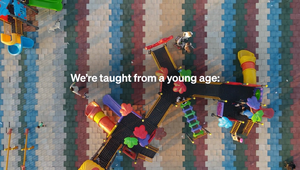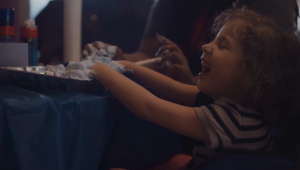
Where Hope Lives: Transforming a Complex Conversation Into a Thought-Provoking Game

What if a simple board game could help parents and children have better, more empathetic conversations about disability? This was the idea that guided The Local Collective to create Where Hope Lives, a new board game created by Safehaven, an organisation supporting children with medical complexities.
Designed to raise awareness and build understanding around a topic many parents feel ill-equipped to talk about, Where Hope Lives combines thoughtful storytelling, subtle metaphor, and hands-on play to gently guide families through the lived experience of medically complex children. The game’s most powerful mechanic? As players learn and progress, their characters slowly become more visible.
LBB’s April Summers spoke with Matt Litzinger, chief creative officer at The Local Collective, to learn more about the creative insight behind the game, the challenge of translating sensitive issues into play, and why visibility is key to changing perceptions
LBB> First things first, can you talk a bit about the insight that sparked this work?
Matt> The insight that drove our approach this year really came from the idea of childhood. More specifically, the way we all believe in the magic of things – and anything is possible.
As kids, even today the most wished for “superpower” is invisibility. That observation helped inform this year’s approach to draw interest in Safehaven and create more relevance for the brand. As we have established last year that 1 in 100 kids is medically complex, but we aren’t seeing them, it helped to create an interesting friction for us.
LBB> Where did the idea to craft an analogue solution like a board game come from?
Matt> There are so many things that exist in the palm of our hands now… literally. But the shared experience of a “traditional” board game creates the type of interactions necessary to make these sensitive conversations we are enabling easier. The success of our analogue solution last year - the One in 100 book - proved the effectiveness of this approach, so we are now extending that even further.
LBB> The stat that “75% of Greater Toronto Area parents say they lack the tools to talk about disability” is really interesting and compelling. How important was data in shaping your creative strategy? And in what ways did it influence the format and messaging?
Matt> Everyone on our team found that stat to be incredibly alarming – and accurate. Often, we are taught from our parents that people with disabilities are different and, due to that difference, we don’t interact with them and are told “not to stare” or “look away” for fear of being rude. That learned behaviour is still being passed on to a new generation of children and is at the core of raising awareness and understanding of our medically complex population. It is the basis for why most parents do not have the tools for proper discussions.
Specific to using data, there’s a lot of it. In fact, it can be overwhelming, so we knew we needed to develop a way to deliver all these data points and informational tools in an engaging way that families and parents could use, while also standing out in a crowded charity landscape. All these factors lead us to the breakthrough of creating a boardgame.
LBB> From a creative perspective, what were some of the biggest challenges in translating something as sensitive as disability and medical complexity into a board game?
Matt> Creatively it was a big challenge. So much goes into building out a functional game that is fun to play and captivating. The teams had to really immerse themselves into the boardgame culture, learning different play techniques and optimal ways to deliver multiple messages – and have fun! There is a unique kind of creative exhaustion that comes from creating 120 headlines and mini ads for all of the play cards, versus a typical print campaign.
LBB> The idea that characters become “more visible” as kids play is such a beautiful metaphor. How did that mechanic come to be, and what role did the metaphor play in the broader creative development of the game?
Matt> Most kids dream of being invisible when dreaming of their favourite superpower to have (if anything was possible). And the fact that medically complex kids represent 1% of our population but are not noticed aligned perfectly with our idea.
Through learning and moving through the game, players begin to understand more about the lived experience of a medically complex child, as the character they are playing becomes more visible – ultimately benefitting the user and our cause.
LBB> Can you walk us through the development of the board game, from early concepting to playtesting?
Matt> Once we developed the idea that a boardgame was the solution to this challenge, our teams really went to work. Lots of different concepts and ideas and playable options were developed, not unlike an ad campaign process, only the “checklist” was much more in-depth obviously. Eventually we landed on the final concept from a playability and “plot” standpoint and then it’s craft, craft, craft.
LBB> Who did you collaborate with to ensure it was accessible, respectful, and engaging? Did you hold focus groups?
Matt> We worked alongside the Safehaven team to ensure all levels of accessibility and respectfulness were being met. From both a conceptual and language standpoint, making the game engaging was an exhausting play and learn process. Our teams played over a hundred times trying to “break” the game and to poke holes in things.
LBB> What role did Safehaven play in the creative process? Were there any stories or moments from their community that shaped the direction?
Matt> Our agency has worked alongside Safehaven for a couple of years now. We take this relationship very personally. Every person at Local has shared numerous experiences with both the staff and the users of Safehaven. There is such an established trust and respect between us that helps make the development of ideas seamless.
LBB> What does success for Where Hope Lives look like for you?
Matt> I hope that people get the game and play it with their significant others. Learning and understanding what living with medical complexities is like and, through that, begin to not only change the way they interact with medically complex people but also how they support them.
LBB> Finally, can you tell us something that you learned through working on this project that’s stayed with you?
Matt> The world needs more people that are like the people that work and support Safehaven. These medically complex families are faced with so many challenges and when you meet them and get to know them it is so compelling. I’m just glad an organisation like Safehaven exists to help change and shape these lives in a fuller way. Oh, and making a board game is really, really, hard.
Find out what else The Local Collective has been working on here















